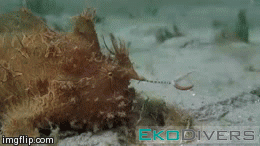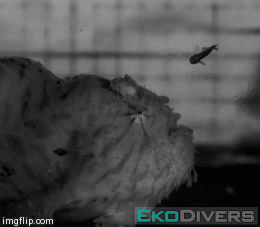
To the average person, the frogfish must look like a childhood monster that had just crawled out of primordial soup. They barely resemble fish, with their scaleless bodies and ungainly waddle. A squat and stocky creature, the frogfish is a master of deception, employing the art of camouflage to its advantage.

While most other animals camouflage themselves to hide from predators, frogfish use this to seduce their prey. Frogfish utilize warts, spots, stripes, skin flaps and filaments to blend into their surroundings, be it a plant, a rock or another animal. Some frogfish look like sponges or algae-covered rocks, presenting a shelter or food source for some fish. These fish are then eaten when they approach too close.

Besides passive camouflage, the frogfish also seduces prey with its lure through a strategy known as aggressive mimicry. The front-most dorsal fin is actually an illicium (rod) which ends in an esca (lure), which can imitate the form and movement of a small prey creature, such as a wriggling worm, a darting fish or a squirming shrimp.

Once a fish approaches the frogfish’s lure, the frogfish positions itself for the attack, either by slowly stalking the prey, or angling its mouth. As soon as the prey is within the attack zone (about one body-length away), the frogfish juts out its jaws and swallows it whole. By expanding the oral cavity up to 12 times its size, the frogfish is able to engulf its prey through the suction pressure inside the mouth. The attack may be as quick as 6 milliseconds – the fastest amongst fish.
With their excellent camouflage and unusual feeding strategy, frogfish seldom have move to evade predators or chase after prey. When they do move, they often use their modified fins to walk or even gallop. Frogfish can swim, though they seldom do except to avoid danger or mate.
In Lembeh, divers have found nine different species of frogfish. Join us in tracking down all nine species on our CNY Lembeh Trip (:
